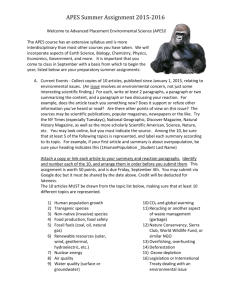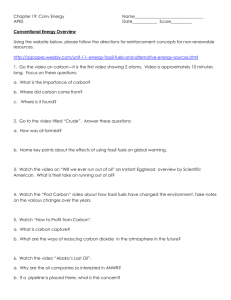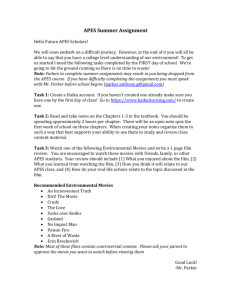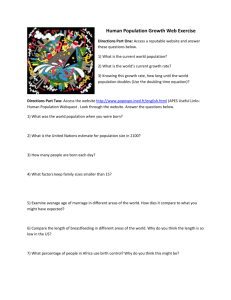APES Summer Assignment 2013
advertisement
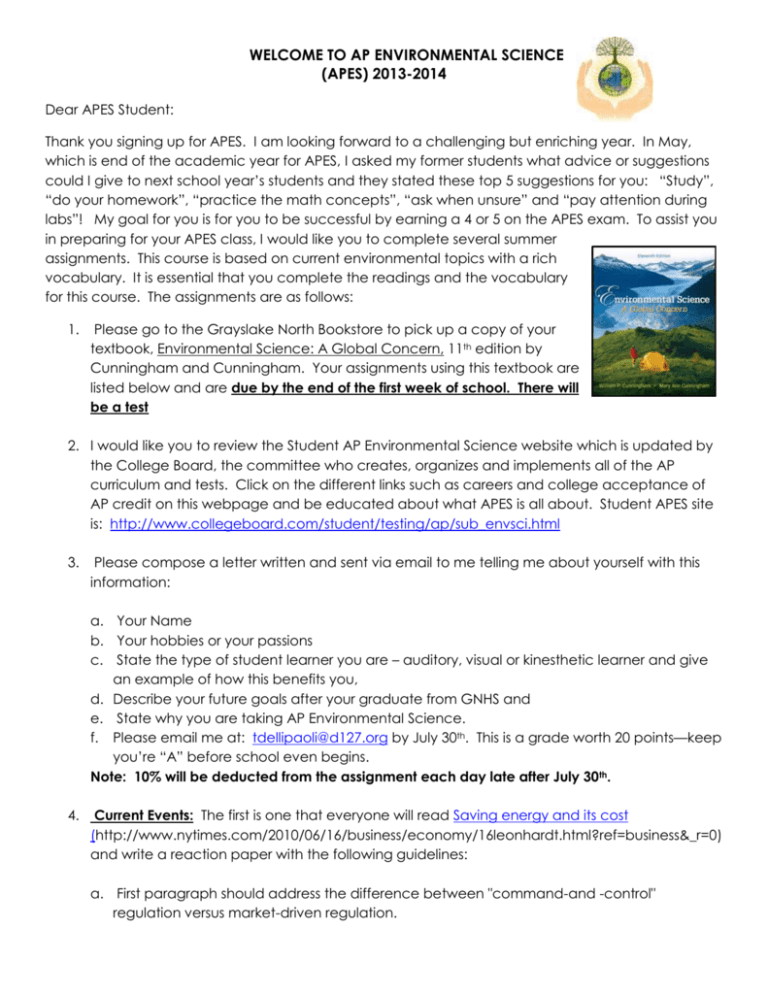
WELCOME TO AP ENVIRONMENTAL SCIENCE (APES) 2013-2014 Dear APES Student: Thank you signing up for APES. I am looking forward to a challenging but enriching year. In May, which is end of the academic year for APES, I asked my former students what advice or suggestions could I give to next school year’s students and they stated these top 5 suggestions for you: “Study”, “do your homework”, “practice the math concepts”, “ask when unsure” and “pay attention during labs”! My goal for you is for you to be successful by earning a 4 or 5 on the APES exam. To assist you in preparing for your APES class, I would like you to complete several summer assignments. This course is based on current environmental topics with a rich vocabulary. It is essential that you complete the readings and the vocabulary for this course. The assignments are as follows: 1. Please go to the Grayslake North Bookstore to pick up a copy of your textbook, Environmental Science: A Global Concern, 11th edition by Cunningham and Cunningham. Your assignments using this textbook are listed below and are due by the end of the first week of school. There will be a test 2. I would like you to review the Student AP Environmental Science website which is updated by the College Board, the committee who creates, organizes and implements all of the AP curriculum and tests. Click on the different links such as careers and college acceptance of AP credit on this webpage and be educated about what APES is all about. Student APES site is: http://www.collegeboard.com/student/testing/ap/sub_envsci.html 3. Please compose a letter written and sent via email to me telling me about yourself with this information: a. Your Name b. Your hobbies or your passions c. State the type of student learner you are – auditory, visual or kinesthetic learner and give an example of how this benefits you, d. Describe your future goals after your graduate from GNHS and e. State why you are taking AP Environmental Science. f. Please email me at: tdellipaoli@d127.org by July 30th. This is a grade worth 20 points—keep you’re “A” before school even begins. Note: 10% will be deducted from the assignment each day late after July 30 th. 4. Current Events: The first is one that everyone will read Saving energy and its cost (http://www.nytimes.com/2010/06/16/business/economy/16leonhardt.html?ref=business&_r=0) and write a reaction paper with the following guidelines: a. First paragraph should address the difference between "command-and -control" regulation versus market-driven regulation. b. The next paragraph should address the role of public education in the issue, using the broadest sense of what constitutes education. c. In the last paragraph, please explain what we mean by "carrot and stick" and give are some examples of carrots and sticks with respect to environmental issues. d. Finally, please find an article for 3 of the 10 following topics and: i. ii. iii. iv. v. Write a summary and opinion/ reaction for it. Include an URL link to the article The written portion should be about 1 page long at 1.5 spaces (longer is acceptable, especially if you want to double space it, instead). You are expected to spend about half an hour on each topic. Please keep in mind the position of the person writing the article, and address any source of bias on the author’s part. You may choose a blog or company website, but then the issue of bias is of greater importance. Wikipedia pages are not appropriate for this. Other, good sources include NPR, The New York Times, the BBC, The Economist, National Geographic, etc. The topics to choose from: - Species Conservation - Availability of drinking water - Water Pollution - Air Pollution - Agriculture - Mining - Nonrenewable Energy Sources - Climate Change - Environmental Legislation - Human Health This assignment is due on the first day of class. The first paper is worth 10 points, with each of the subsequent article summary/reaction is also worth 10 points each, for a total of 40 points. That’s roughly the same as a test, so please take advantage of your time this summer to start off the year with an easy A. Chapter 1: Understanding our Environment 1. Read and outline Chapter 1 in a notebook or on looseleaf paper. (I included strategies for note-taking at the end of this letter.) 2. Create flashcards for the bolded vocabulary or by using www.quizlet.com and you can set up electronic flashcards that can be saved and referred to throughout the year. 3. Write an overview of the introductory case study on p. 13 China’s Green Future. 4. The Environmentalists: Create a timeline of the environmentalists and their contribution to the environment and sustainability. Be sure to include: President Roosevelt, Gifford Pinchot, John Muir, Aldo Leopold Rachel Carson, David Brower, Barry Cimmoner and Wangari Maathai. Chapter 2: Principles of Science 1. Read and outline Chapter 2 in a notebook or on loose leaf paper. (I included strategies for note-taking at the end of this letter.) 2. Create flashcards for the bolded vocabulary or by using www.quizlet.com and you can set up electronic flashcards that can be saved and referred to throughout the year. I do have a teacher webpage and be sure to click on AP Environmental Science: http://north.d127.org/teachers/tdellipaoli/apes/Pages/default.aspx but I am in the process of updating it for the new school year. Feel free to look around. I will be posting these assignments on my webpage and so you can click on the links without typing them. I look forward to sharing and learning with you in APES this coming academic year. If you have any concerns or questions, please email at tdellipaoli@d127.org and I promise to get back with you within 24 hours. Sincerely, Mrs. Delli Paoli, AP Environmental Science Notetaking Suggestions: Notetaking is a personal way to learn. If you have a note-taking system that works for you and allows you to be thorough, by all means use your own system. I am recommending this for students who do not have a structured method for taking notes. Set up your outline using the Cornell method. You can use numbers and letters to designate a new / major heading or concept. Evidence or supporting statements can be shown as bullets, letters or numbers. If unsure on how to use this method, watch the You Tube video at the link below: http://www.youtube.com/watch?v=Suhc7AX97a8&feature=related APES Summer Assignment 2013 Name__________________________________ Period____ Date__________ Score_______/105 Grading Rubric Topic Obtained book from bookstore during summer Letter of Introduction Due by 7/30/13 Letter of Introduction received on time Energy Reaction Paper: Command & Control Public education Carrot & Stick 2nd Current Event 3rd Current Event 4th Current Event Chapter 1 Outline Chapter 1 Flashcards 4 Obtained book Well-written introduction which contains all 6 aspects of the assignment. Received on time Well written summary which includes all requirements for this current event. 3 Well-written introduction which contains most of the aspects of the assignment. 2 Good – written introduction which contains all 6 aspects of the assignment. Well-written which includes most of the requirements Good – written energy current event which contains most of the requirements. Well written summary which includes all requirements for this current event. Well written summary which includes all requirements for this current event. Well written summary which includes all requirements for this current event. Comprehensive outline of the chapter content. Well-written which includes most of the requirements Good – written energy current event which contains most of the requirements. Good – written energy current event which contains most of the requirements. Good – written energy current event which contains most of the requirements. All vocabulary outlined on notecards or on quizlet. 75% of vocabulary outlined Well-written which includes most of the requirements Well-written which includes most of the requirements 50% of the vocabulary outlined 1 0 X2.5 = /10 Poorly written introduction letter. X5 = /20 Not received on time. Poorly written reaction paper. X2.5 = /10 X 2.5= /10 Poorly written reaction paper. X 2.5= /10 Poorly written reaction paper. X 2.5= /10 Poorly written reaction paper. X 2.5= /10 Poorly completed outline of the chapter content. 25% of the vocabulary outlined /5 /5 Chapter 1 Environmentalist Timeline Timeline is detailed with year & contribution Chapter 2 Outline Comprehensive outline of the chapter content. Chapter 2 Flashcards All vocabulary outlined on notecards or on quizlet. Total Points 75% of vocabulary outlined 50% of the vocabulary outlined Timeline is incomplete and/or does not state their contribution to the environment. Poorly completed outline of the chapter content. 25% of the vocabulary outlined /5 /5 /5 /105 AP Environmental Science Summer Packet 2013-2014 Student Name__________________________________ Mrs. Delli Paoli email: tdellipaoli@d127.org

